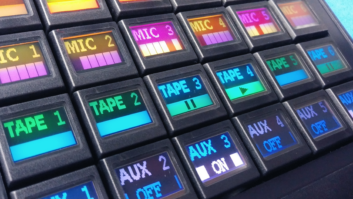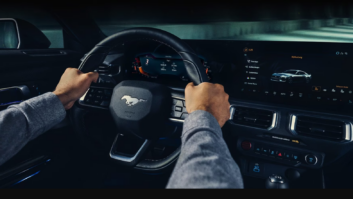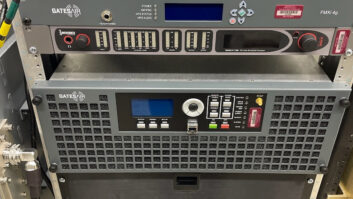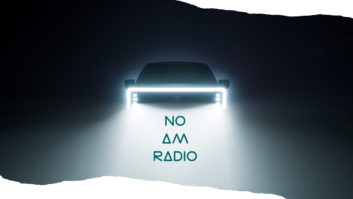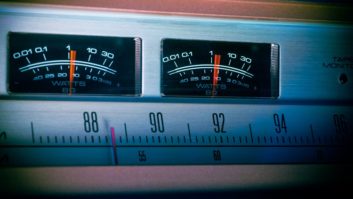Photo Credit: iStockphoto/TTGuy Wire is the pseudonym for a veteran broadcast radio engineer. Opinions are his own. Find past articles under the Columns tab at radioworld.com.

The AM band has been in deep trouble for a long time. AM stations struggle almost everywhere to be successful, even many big-signal facilities in large markets. A growing number of owners seem to have little interest in improving or fully supporting their AM properties. Their FM sisters subsidize the expenses to keep them alive. And sadly, more AM stations are going dark as licenses are simply being turned in and their assets liquidated.
FM surged into the lead as the preferred broadcast band for the majority of radio’s audience almost 30 years ago. Internet delivery eventually will challenge FM’s dominance. Nobody would disagree that other bands and technologies are much better suited than AM to drive our industry forward.
Has the time arrived to give up the noise and interference-infested senior broadcast band to the power companies for load bank switching and move on?
CONCERN AT THE TOP
FCC Commissioner Ajit Pai, along with a significant group of AM owners and aligned interests, don’t think so. Pai has been a welcome breath of fresh air for AM fans everywhere since he announced his full support for AM revitalization. He moderated a panel on the topic and led the discussion at April’s NAB Show, the first time in history a sitting FCC commissioner has done so.
As RWEE Editor Michael LeClair pointed out in the previous issue, we’ve done all the small stuff to help save AM radio and it hasn’t worked. In spite of its best intentions, many of the FCC rules enacted since AM began declining have actually stifled its ability to survive and thrive.
We’ve reached a tipping point for AM. Tweaking existing rules won’t likely go deep enough or far enough to help. The band needs big and bold ideas with implementation to save it long-term.
Pai’s NAB panel discussion tackled all the various options and “solutions” to the AM problem. Every one entails considerable caveats and conditions that make them difficult to execute and become effective. Every engineer and communications attorney will probably have a different opinion about how realistic, doable and effective each one could be.
Let’s take a look at various proposed solutions being tossed around. I’ll list them in order of “doability” and effectiveness, according to my own crystal ball.
1. FCC allowing AM stations more flexibility to seek out, move and acquire FM translators to simulcast their programming on a priority, “one to a customer” basis.
Granting the pending Tell City Waiver request set the precedent for many AMs constrained by the strict limits on moves of FM translator transmitter sites and channel modifications. Compared to all the other options, this is by far the easiest. But it would mostly only help stations in smaller markets outside of the larger metro areas that are able to find and purchase a commercial channel translator in a wider radius around their AM station.
This buys some extra time for the lucky stations that get a translator until all-digital AM becomes standardized or until the band dies completely … or if Internet and WiMax delivery makes over-the-air AM/FM broadcasting useless. Most of us won’t be around when that happens.
2. FCC opening an AM-only filing window for FM translators.
Some broadcasters are advocating for an AM-only window for filing for FM translators in addition to a grant of the Tell City Waiver. This could help some additional stations in the smaller markets, if the required Rule Making to create the window is accomplished quickly. With many of the pending LPFM applications filed back in 2003 now being granted, the availability of channels will shrink dramatically. Rule Makings usually take years to enact. With time running out for AM analog, the FCC should fast-track such a proceeding and also give existing AM’s priority to acquire older translator licenses that are not renewed for any reason.
3. FCC setting an AM analog sunset date and mandating conversion to all-digital by that date.
Most clear-thinking owners and operators of the nation’s still successful AM stations see this option as the best long-term solution for saving AM. Even though only a few hundred existing stations have adopted hybrid analog-digital AM, enough time has elapsed to establish a de facto standard as our only realistic option: iBiquity’s all-digital AM-HD.
I realize that much of the industry is still not happy that iBiquity remains private and proprietary, and won’t share its code so others might contribute to its improvement. We can only hope that will eventually change.
An FCC mandate that all new radios sold must include HD capability would give this option a huge boost. HD Radio receivers in the hands of consumers now can already receive all-digital AM-HD.
It is going to be very difficult to establish this mandate since the CEA and other interests will undoubtedly fight it. But it’s the only ace card we have left to play in the AM hand if the game is to continue.
4. FCC rescinding various existing counter-productive and outdated rules.
Those include the “Ratchet Clause” for AM NIF protection limits, the required 80 percent city of license coverage requirement and the necessity for minimum efficiency antennas. These could all be rescinded fairly easily if the commission made it a priority.
The Ratchet Clause mostly prevented many stations from investing in meaningful signal coverage improvements since it required reduced coverage in the null areas. Removing the 80 percent city of license rule would allow a few marginal stations to be able to relocate sites, but possibly lose important coverage. Being able to use short antennas would also enable some stations to relocate and reduce antenna construction expense. But realistically, removing these roadblocks would do little to help most AM stations now. It’s like running a garden hose into the ocean to raise the tide.
5. FCC adopting tougher rules limiting noise levels emitted by electrical and electronic devices.
RF light bulbs and all kinds of consumer and industrial devices that are powered by electricity and emit RF would have to be regulated for this option to be effective. And that includes those nasty power lines, noisy transformers and electric mass transit offenders. But even if the commission could adopt tougher rules in the face of CEA and other opposition, trying to enforce them would create a bureaucratic nightmare for an already understaffed and under-funded FCC. Except for Commissioner Pai, it’s becoming rather obvious the FCC doesn’t really care that much about AM receiver noise interference. In any case, with many billions of AM noise-generating devices already out in the real world, there is no way to put that Pandora back in the box. It’s the wireless, Wi-Fi and WiMax bands they want to protect going forward.
6. FCC adopting and enforcing better AM analog receiver specs to mitigate noise interference.
The FCC could establish guidelines like the preferred use of DSP, synchronous detectors and better noise suppression designs in receivers. Enacting any hard rules for receiver performance benchmarks would no doubt bring CEA opposition. As in #4, enforcing new rules would be very difficult with so many radios coming in as imports, plus the existence of a billion radios already in use. As with the AMAX initiative, this issue will likely only get lip service.
7. FCC granting across-the-board power increases to existing stations.
While this sounds like a good idea, the amount of power increase needed to be effective to override today’s very high environmental noise levels would have to be many times higher than existing levels to do any good. Merely doubling or tripling power levels would produce little improvement in most locales.
Implementing very high power increases for most existing stations is simply not economic or realistic. And, there are the international treaties on foreign clear and shared channels regarding interference protection, which would be difficult to renegotiate.
8. FCC allowing cellular type repeaters for AM stations to augment coverage.
This might be the most unrealistic pie-in-the-sky idea in the entire list. The complexity and expense of implementation and maintenance in most cases vastly outweighs any potential improvement and return. Only a very few FM stations are seriously looking at this option. Why would struggling AMs even consider it?
9. FCC allowing the migration of existing AM stations to TV Channels 5 and 6 (76–88 MHz).
This plan was first presented in detail in 2008 by a group called the Broadcast Maximization Committee. They proposed using a modified all-digital 100 kHz channel scheme so that all existing AM stations could fit into 12 MHz of new spectrum with room for some other goodies. It could also be done using analog or hybrid analog-digital. This idea has received significant radio industry support with proponents assuming the new channels would be awarded for free in exchange for eventually vacating AM. But existing TV stations still using these channels along with many dozens of LPTV applicants wanting the spectrum makes this a difficult sell for both the NAB and FCC. Plus there are too many business reasons this plan is a non-starter.
The government and the commission are looking for new sources of revenue so they favor auctioning off spectrum for new uses to the highest bidder. Most spectrum reallocation and repurposing initiatives have been paid for by the new users via auction. In this case, the displaced users will want compensation, so the FCC would likely require existing AM station owners migrating into 76–88 MHz to pay something.
Without ready-to-use radio receivers for any new 76–88 MHz spectrum in the hands of U.S. consumers, the extra burden of not only paying for and operating a new FM channel along with maintaining the existing AM signal until enough new FM receivers are in use makes this option unappealing as a business model.
BEST POSSIBILITIES
It’s rather obvious to me that the most feasible options boil down to awarding as many FM translators to existing AMs as possible and then mandating an analog sunset in favor of all-digital AM (#1, #2 and #3 above).
Options #4, #5, #6, #7 and #8 will have little meaningful impact even if adopted. I don’t see expanding available spectrum for radio (#9) ever happening. It’s becoming clearer with each passing year that the analog AM band has become less and less desirable for much of anything. Its prospects in an all-digital world change significantly, as evidenced by the recent all-digital field testing in North Carolina.
The grapevine is saying several major group CEOs have suggested a 10-year sunset limit on analog AM radio. After that, all-digital should be mandated. HD Radio sales and penetration continues to grow at a slow but steady pace. Ten years seems reasonable since that’s the average lifespan of cars in regular use, and many new cars now include HD receivers capable of receiving AM HD.
I’m betting that many existing AM licensees of marginal stations would be willing to give them up if the FCC and NAB could craft an attractive incentive to do so. If the stations that want to keep them can migrate to FM translators, the band will at least partially cleanse itself. That leaves a real opportunity for those owners who see long-term value in the advantages of keeping the AM band alive with new and much improved technology.
For the all-digital AM-HD mandate to happen, the FCC and broadcasters alike are going to have to muster some real courage and perseverance to get it done. Mr. Pai has a unique opportunity to change the course of history. Otherwise, the AM branch will simply wither and die on the electromagnetic vine.
Comment on this or any story. Write to[email protected]with Letter to the Editor in the subject field.







